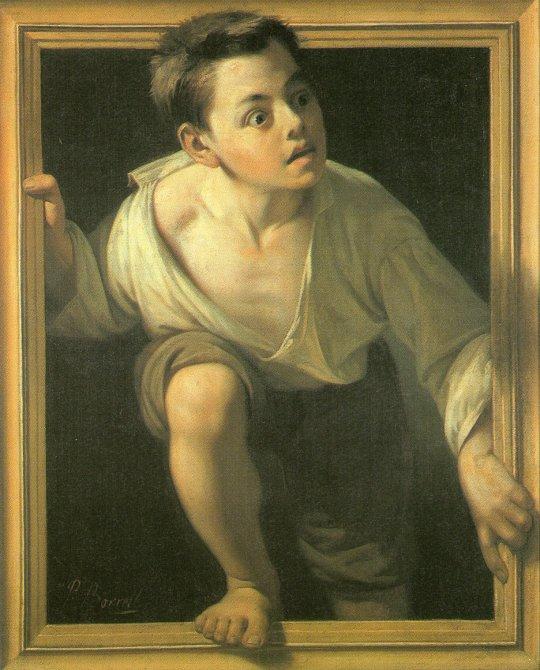Art is not what you see, but what you make others see - Edgar Degas
Art is not what you see, but what you make others see - Edgar Degas
optical illusion aesthetics
Vision is one of the five human senses and is the most important sense in human life. It can be said that humans think as they see and see as they think. The phenomenon of digging into these loopholes and failing to accurately recognize objects and causing visual illusions is called optical illusion. The use of optical illusions appears well in art. Trompe l'oeil is French for 'trick of the eye', and refers to a painting and such an expression technique that confuses a picture with a real object through a very realistic expression. . How do two-dimensional paintings make us have this illusion?

error in interpretation
In order for humans to see something, there must first be light. Light hits an object and passes through the cornea, the outermost part of the eye, and the lens, which acts as a lens, to form an image on the retina. Visual cells that detect color and contrast in the retina are excited by light, which is transmitted to the visual cortex of the cerebrum through the optic nerve, and we receive visual information. As the brain interprets this visual information, we can recognize objects. In other words, even if there is no problem with visual information, errors that appear in the process of interpreting information by the brain are optical illusions.
![호기심 과학] 눈으로 보는 것이 모두 사실이 아니라고? 뇌는 눈을 속일 수 있다! '착시의 세계' | 삼성디스플레이 뉴스룸](http://news.samsungdisplay.com/wp-content/uploads/2021/04/13.jpg)
distorted image, anamorphic
One of the art techniques that make good use of the principle of optical illusion is the anamorphic technique. The anamorphic technique, which means 'distorted image', shows the shape intended by the artist when viewed from a specific angle or in a specific way. It is an optical illusion art technique that utilizes the fact that the information received visually differs depending on the angle or direction of looking at an object. This is evaluated as a sophisticated and high-level technique that is completed only through mathematical and scientific calculations based on a thorough understanding of perspective.

inversion of distortion
Anamorphic techniques can be largely divided into techniques that use mirror distortion and techniques that are distorted according to viewpoints. At first glance, it is a distorted picture that is incomprehensible, but if you place a cylindrical mirror in an appropriate location, you can find the original picture that was hidden. It is to use the distortion of the cylindrical mirror inversely to create a new image in the distorted world.

The mirror-type anamorphic technique is relatively free from the point of view in appreciating the work compared to the viewpoint-type anamorphic technique. This means that you can view it from a slightly different angle through a mirror.
medium of meaning
Anamorphic technique is used in various fields beyond a simple art technique. Optical illusions can draw people's attention and cause interest and fun, so anamorphic techniques are often used for the purpose of conveying specific values to many people, such as advertisements. With wit that deceives the eyes and brain, it gives surprise and freshness, stimulates curiosity, and makes people immerse themselves in the work.
In advertisements for Honda Motors, anamorphic technology was used to break down the boundary between reality and painting, giving a great sense of freshness. In fact, Honda was recognized for its novelty by winning a bronze medal at the Clio Advertising Festival through this advertisement.
Anamorphic and digital technology
In order to see anamorphic works of art, it is necessary to view them from a specific point of view, so active viewing is required from the viewer. These characteristics are combined with extended reality, which is in the spotlight recently, and the infinite possibilities are attracting attention. Anamorphic art, which was confined to canvas, met digital technology and transcended the limits of physical space. Anamorphic, realized through a large LED screen, creates a virtual three-dimensional space within a flat screen, creating the illusion that a space actually exists inside the screen.
Love Earth, Switch Off (The Darkness That Saves the Earth)
Another example of the use of anamorphic techniques is the “Love Earth, Switch Off (Darkness that Saves the Earth)” campaign exhibited at Starfield Hanam. A three-dimensional space is created in the large media tower located in the center of Starfield, and realistic graphics give the impression of being able to walk inside the media tower at any moment.

It is differentiated from other anamorphic content in that it can directly participate in the content by recognizing the QR code and conveys the message that small actions such as turning off the switch can save the earth. Media art group 'CUZ' is conducting various campaigns using anamorphic techniques and XR technology to raise social awareness of environmental issues.
Closing remarks
The medium is the message – Marshall McLuhan
Depending on the characteristics of the medium containing the content, it affects the way the viewer accepts it. When combined with anamorphic techniques and XR technology, as in CUZ's campaign, the endless possibilities of interactive media contents are highly expected.
Tags
- anamorphic, CUZ, LOVE EARTH, media art, SWITCH OFF, Gyeonggi Content Agency, media art, anamorphic, darkness of the earth, Curze, Hanam Starfield
